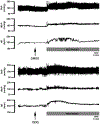The influence of paraventricular nucleus of the hypothalamus soluble guanylate cyclase on autonomic and neuroendocrine responses to acute restraint stress in rats
- PMID: 39235324
- PMCID: PMC11609759
- DOI: 10.1111/ejn.16527
The influence of paraventricular nucleus of the hypothalamus soluble guanylate cyclase on autonomic and neuroendocrine responses to acute restraint stress in rats
Abstract
The paraventricular nucleus of the hypothalamus (PVN) regulates physiological and behavioural responses evoked by stressful stimuli, but the local neurochemical and signalling mechanisms involved are not completely understood. The soluble guanylate cyclase (sGC) within the PVN is implicated in autonomic and cardiovascular control in rodents under resting conditions. However, the involvement of PVN sGC-mediated signalling in stress responses is unknown. Therefore, we investigated the role of sGC within the PVN in cardiovascular, autonomic, neuroendocrine, and local neuronal responses to acute restraint stress in rats. Bilateral microinjection of the selective sGC inhibitor ODQ (1 nmol/100 nl) into the PVN reduced both the increased arterial pressure and the drop in cutaneous tail temperature evoked by restraint stress, while the tachycardia was enhanced. Intra-PVN injection of ODQ did not alter the number of Fos-immunoreactive neurons in either the dorsal cap parvocellular (PaDC), ventromedial (PaV), medial parvocellular (PaMP), or lateral magnocelllular (PaLM) portions of the PVN following acute restraint stress. Local microinjection of ODQ into the PVN did not affect the restraint-induced increases in plasma corticosterone concentration. Taken together, these findings suggest that sGC-mediated signalling in the PVN plays a key role in acute stress-induced pressor responses and sympathetically mediated cutaneous vasoconstriction, whereas the tachycardiac response is inhibited. Absence of an effect of ODQ on corticosterone and PVN neuronal activation in and the PaV and PaMP suggests that PVN sGC is not involved in restraint-evoked hypothalamus-pituitary-adrenal (HPA) axis activation and further indicates that autonomic and neuroendocrine responses are dissociable at the level of the PVN.
Keywords: PVN, sGC; cardiovascular responses; corticosterone; sympathetic activity.
© 2024 Federation of European Neuroscience Societies and John Wiley & Sons Ltd.
Conflict of interest statement
Conflict of Interest
All authors declare that they have no conflicts of interest.
Figures





References
-
- Amir S, Rackover M, & Funk D (1997) Blockers of nitric oxide synthase inhibit stress activation of c-fos expression in neurons of the hypothalamic paraventricular nucleus in the rat. Neuroscience, 77, 623–627. - PubMed
-
- Bains JS & Ferguson AV (1997) Nitric oxide depolarizes type II paraventricular nucleus neurons in vitro. Neuroscience, 79, 149–159. - PubMed
-
- Benini R, Oliveira LA, Gomes-de-Souza L, & Crestani CC (2019) Habituation of the cardiovascular responses to restraint stress in male rats: influence of length, frequency and number of aversive sessions. Stress, 22, 151–161. - PubMed
-
- Benini R, Oliveira LA, Gomes-de-Souza L, Rodrigues B, & Crestani CC (2020) Habituation of the cardiovascular response to restraint stress is inhibited by exposure to other stressor stimuli and exercise training. J Exp Biol, 223. - PubMed
-
- Bhatnagar S, Dallman MF, Roderick RE, Basbaum AI, & Taylor BK (1998) The effects of prior chronic stress on cardiovascular responses to acute restraint and formalin injection. Brain Res, 797, 313–320. - PubMed
MeSH terms
Substances
Grants and funding
- 2009/05308-8/Fundação de Amparo à Pesquisa do Estado de São Paulo
- R01 MH049698/MH/NIMH NIH HHS/United States
- 2023/03044-0/Fundação de Amparo à Pesquisa do Estado de São Paulo
- 2018/04899-1/Fundação de Amparo à Pesquisa do Estado de São Paulo
- 2012/09425-1/Fundação de Amparo à Pesquisa do Estado de São Paulo
LinkOut - more resources
Full Text Sources
Medical
Miscellaneous

